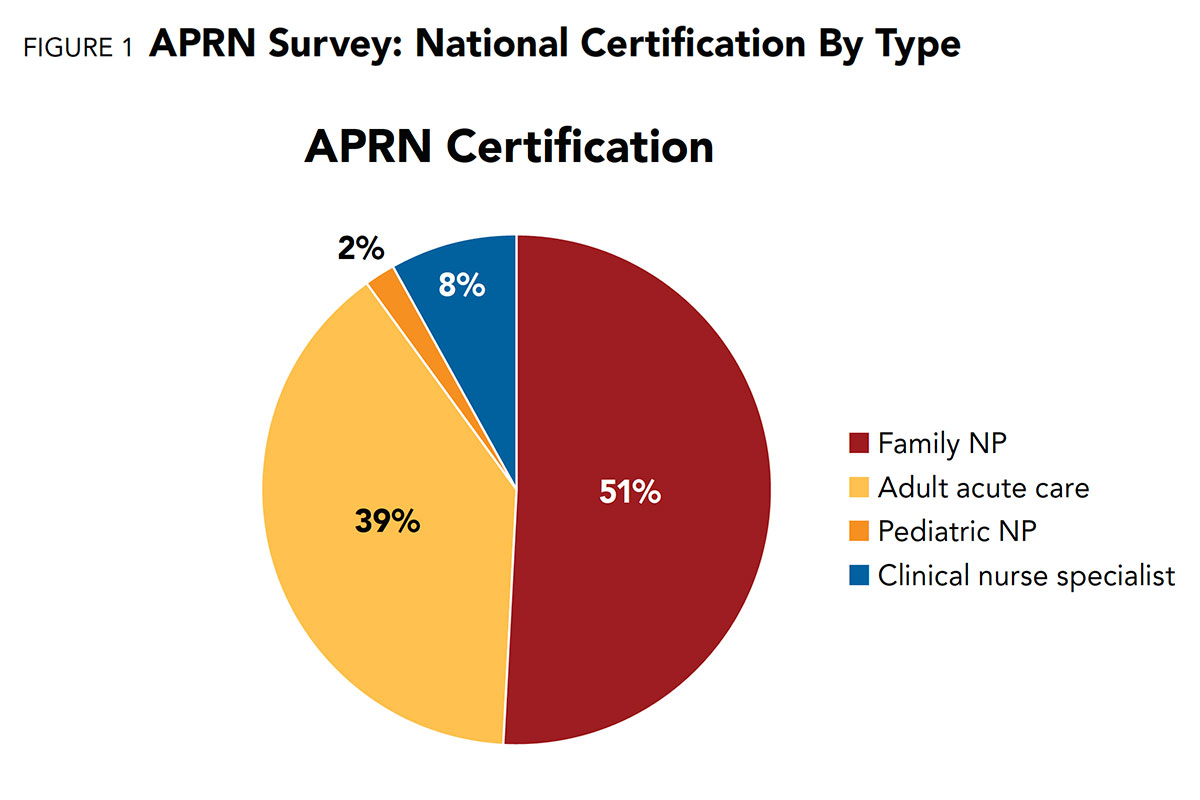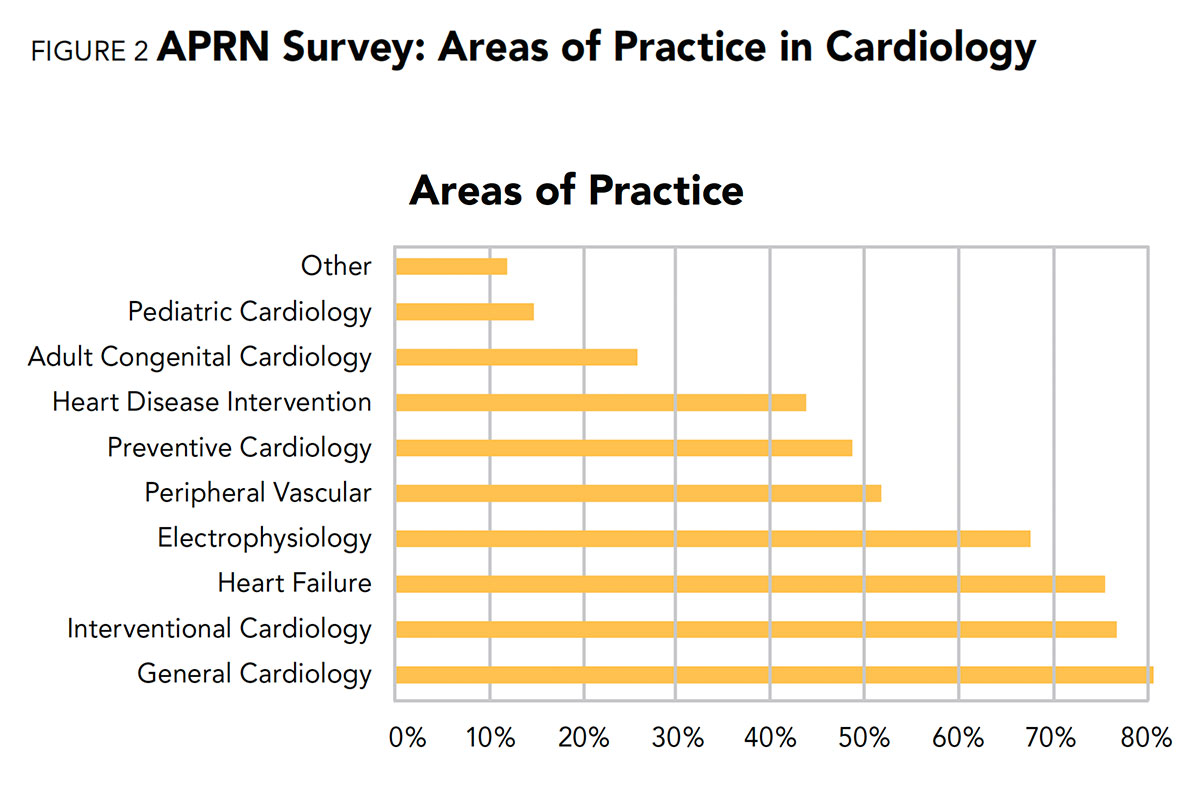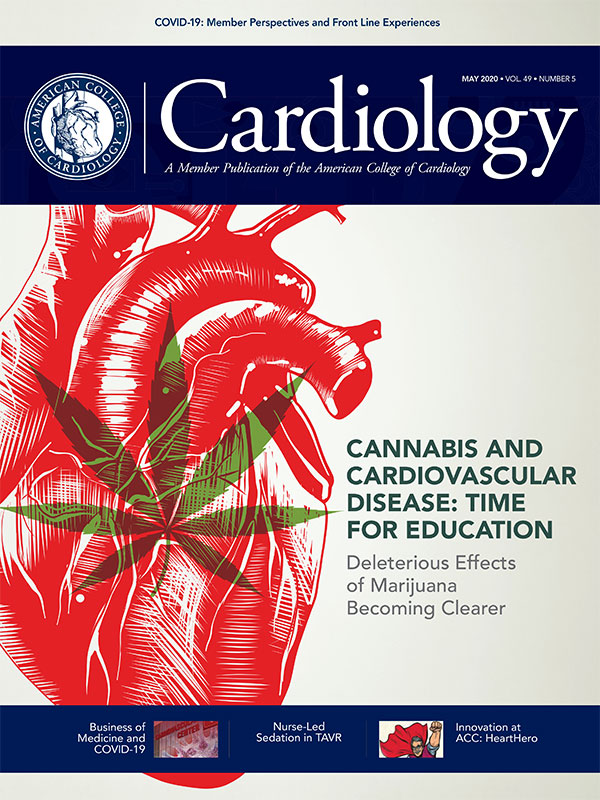The Emerging Role of Advanced Practice Registered Nurses in Cardiology: Insights From the ACC APRN Survey

Advanced practice registered nurses (APRNs) continue to assume an increasing role in the care of individuals with cardiovascular disease. Although APRNs include nurse practitioners (NPs), clinical nurse specialists (CNSs), nurse anesthetists and nurse midwives, this article focuses on NPs and CNSs.
Depending on their scope of practice and role, APRNs function across the continuum of care, and provide care in acute care facilities, nursing homes, primary care clinics, outpatient clinics and offices, and other areas.
APRN Survey Results
The majority of APRNs who responded to the survey were NPs with national certification as family nurse practitioners (43%) followed by adult acute care (29%). Only three respondents were certified as pediatric NPs. CNSs represented 7% of respondents (Figure 1).

The highest level of education achieved was a Master's degree for 76%, a Doctor of Nursing Practice (DNP) for 17% and PhD for 5%.
For respondents with a Master's degree, only 22% said they planned to further their education, although the reasons for this were not captured with the survey questionnaire.
Most of the APRNs ranged in age between 36 and 45 years (31%), with 24% over the age of 55. The greatest range for the number of years practicing in cardiology was over six years.
The vast majority (81%) worked full-time as direct patient care providers in hospital-based practices in urban areas.
Very few had administrative (16%) or research positions (6%). These demographics are consistent with data published by the American Association of Nurse Practitioners (AANP) in 2018.1
In our ACC study, the top three areas of practice of the respondents were general cardiology (81%), interventional cardiology (77%) and heart failure (76%) (Figure 2).

With respect to workload, the majority (35%) of respondents reported they had fewer than 25 inpatient encounters per week; 27% reported 26-50 encounters; 12% reported 51-75 encounters; and 3% more than 75 inpatient encounters. (Note that one patient seen on three separate days represents three encounters.)
For respondents who performed inpatient rounds, most (46%) reported a typical daily patient load of less than 10 patients; 39% reported 11-20 patients and 7% reported more than 21 patient encounters.
The primary responsibilities reported by the survey respondents were: patient education (67%), cardiology consults (65%), outpatient follow-ups (64%), hospital rounds (58%) and admission history and physicals (52%). (Note the percentages do not total 100 because more than one responsibility could be selected.)
A minority of respondents (less than 10%) performed procedures, such as elective cardioversion, catheter placement and/or endotracheal intubation.
APRN Survey Design
The APRN Work Group of ACC's CV Team Member Section developed and conducted a survey to better understand the roles and responsibilities of APRNs, as well as determine their potential education needs.
The 2019 Cardiology Advanced Practice Registered Nurses Workforce Survey was similar with one conducted the year before on the physician assistant workforce.
The APRN survey consisted of 34 questions that addressed demographics, place of employment, role and responsibilities, financial aspects and barriers to practice.
The survey was emailed to 2,600 APRN members of ACC and was promoted by six email invitations, the CV Team Section e-newsletter and CV Team State Liaisons, including information about deadline extensions.
As a result, 262 individuals (248 NPs; 14 CNSs) responded to the survey, corresponding to a 10% response rate that is consistent with response rates of other ACC surveys, which have averaged from 7-10%. Data are reported in aggregate based on response rates to each question.
Regarding role expectations, 56% of the APRN respondents reported being able to practice to the full level of their education and training, while 39% reported sometimes they were able to and 5% reported they never were able to practice to their full level.
This lack of autonomy may be related to the barriers reported in our survey. One of these barriers was state nurse practice acts (reported by 35%) which do not allow for full practice authority. Others reported barriers were state medical board rulings (24%), institution-wide lack of support for APRNs (29%), departmental lack of support for APRNs (20%), lack of support from direct supervisor (14%) and institutional bylaws (38%).
This provides insight into the majority of survey respondents stating they were only partly satisfied with their role. These barriers to practice are similar with those in an Institute of Medicine (IOM) report in 2011 on The Future of Nursing.2
The IOM report notes that although APRNs are highly trained and able to provide a variety of services, they are unable to practice to the full scope of their education and training due to outdated insurance reimbursement models, institutional practices and culture, state laws and federal policies.
Turning to compensation, the average hourly base pay was between $50-55 (28%), with $35-40 (2%) the lowest and $115-120 the highest (1%). This is lower than the average hourly pay of $63 reported in the national NP survey.1
Incentives reported in our ACC survey included education funds (82%), license reimbursement (71%), DEA registration (73%), medical staff dues reimbursement (31%) and bonuses (24%). The majority of salaries was paid by the department of cardiology (32%), and 9% came from the department of nursing.
Opportunities For APRNs in ACC
ACC Celebrates Nurses Appreciation Month
Nurses deserve our gratitude and appreciation for their commitment to delivering the highest standards of cardiovascular care.
The College is proud to stand by and support nurses – not just during the current pandemic – but always. The work you do is essential for transforming cardiovascular care and improving heart health. You have our heartfelt thanks for all you do.
ACC is offering free membership to new cardiovascular team members during the month of May as part of our support. Visit ACC.org/Join and use the code HereForYou. Applications are always welcome.
Discover all we have for you as a cardiovascular team member at ACC.org/CVT.
Currently, there are 2,971 APRN members in the CV Member Section, of which only 11 are international members. APRNs have become well recognized as valued members of team-based cardiology care,3,4 and work in concert with other providers.
The ACC's Competency Management Committee is developing a competency statement that will describe the key experiences and skills of NPs and physician assistants (PAs) as members of the CV care team, including those in general cardiovascular practice and those working in focused areas of cardiovascular medicine.
The College offers several leadership opportunities for APRNs who wish to foster their professional commitment within cardiology and lend a voice for this discipline.
Other opportunities include joining ACC state chapters, participating in various committees within the CV Team Member Section, particularly the APRN Work Group, and participating in guideline development committees.
Another opportunity is to become an Associate of the American College of Cardiology (AACC). The AACC designation honors cardiology professionals who demonstrate a commitment to their discipline and to the College. Currently, 271 APRNs hold the AACC designation.
Another avenue of distinction for APRNs is to become a Fellow of the American College of Cardiology (FACC). Fellowship is conferred on members with outstanding contributions to cardiovascular medicine and is highly regarded amongst peers and the community. To date, three APRNs have achieved FACC designation.
The abundance of learning opportunities and avenues for professional development through the College, positions the ACC to serve as the professional home of APRNs who practice in cardiology.
References
- Kleinpell R, Cook ML, Padden DL. J Am Assoc Nurse Pract 2018;30:140-9.
- Institute of Medicine. The future of nursing: Leading change, advancing health. The National Academies Press; 2011. Washington, DC. Available here. Accessed Jan. 30, 2019.
- Brush JE Jr, Handberg EM, Biga C, et al. J Am Coll Cardiol 2015;65:2118-36.
- Arnett DK, Blumenthal RS, Albert MA, et al. J Am Coll Cardiol 2019;74:1376–1414.
Clinical Topics: Arrhythmias and Clinical EP, Cardiovascular Care Team, EP Basic Science
Keywords: ACC Publications, Cardiology Magazine, Advanced Practice Nursing, Motivation, Nurse Clinicians, Institutional Practice, Fellowships and Scholarships, Leadership, Inpatients, Electric Countershock, Pandemics
< Back to Listings



